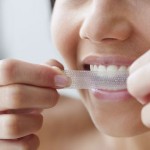 If you’re thinking of whitening your teeth, there are several choices in how to do it and what product to use. Below we will review the following methods:
If you’re thinking of whitening your teeth, there are several choices in how to do it and what product to use. Below we will review the following methods:
Over The Counter, Professional, Take-Home, Online and In-Office whitening products and procedures, for you to compare.
Over-The-Counter Products
Over-the-counter (OTC) whitening gels and solutions are affordable and give fast results. Since they contain a lower percentage of Hydrogen Peroxide than products supplied by dental professionals, be aware you will need to apply them to your teeth with some frequency in order to keep your smile bright.
Keep in mind, also, that some OTC products, such as whitening toothpaste, merely remove surface stain on tooth enamel. If you brush your teeth with whitening toothpaste on a daily basis, your enamel could begin to wear down, causing tooth abrasion.
Professional Take-Home or Online Products
Professional take-home or online products from your dentist are a high concentrate of either Hydrogen Peroxide or Carbamide Peroxide, providing results in one to two weeks of prescribed use. Some online suppliers claim whitening of 2-5 shades.
The process involves pouring teeth-whitening gel or solution into custom-fit trays. The trays must then sit on the surface of the tooth so that the sensitive gum area is only slightly exposed to the bleaching solution.
The cost of these products is considerably less that in-office whitening, but typically not covered under dental insurance plans. Some people report they sometimes forget to use the products or have a difficult time remembering to use them.
Professional In-Office Procedures
At the dentist’s office, you get what you pay for. In a controlled environment and supervised by a dentist, your teeth will be whitened with a high concentration of Hydrogen Peroxide or Carbamide Peroxide. If you’re looking for a quick smile fix in a hurry, this is the best choice, since results are seen in as little as one hour.
Another professional lightening technique uses a laser. Your dentist will apply a 35 per cent Hydrogen Peroxide solution to your teeth. Then, a light will be held a couple of inches away from your teeth to speed up the bleaching process.
Although these procedures are regarded as the best options for teeth whitening, they are expensive, and dental plans typical don’t cover them.
The Best Choice for You
It’s a fact that teeth whitening products and procedures work. For both men and women, at affordable prices, and often within a very short amount of time.
Bleaching techniques are now so advanced that even some deep-set, stubborn stains can be removed. If your teeth are heavily stained, your best bet might be a professional, take-home whitening kit that you maintain over a period of months or even a year.
Maintenance is key no matter which whitening process you choose because bleaching isn’t permanent. In time, stains will re-appear on dental enamel, and organic debris will re-enter enamel cracks, leaving teeth looking dull or dingy.
Regular “touch ups” will help you maintain their lighter shade. Some people can limit touch-ups to once a year; others will need them more often. With touch-ups, you can stick with the bleaching method you first used, or switch to another one.
Don’t expect miracles when you first whiten your teeth, no matter how you choose to do it. Expectations should be realistic, since teeth results vary from person to person.
The shade tooth color guides used by dentists show that most of us who bleach our teeth are likely to see a change of two to seven shades—significant “before and after” results. Some lucky individuals see a change of nine shades or more.
If you are disappointed at first in your whitening results, remember that they are not fully seen until approximately two weeks after bleaching.
